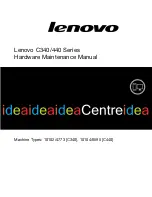
v
Follow
the
suggested
actions
in
the
order
in
which
they
are
listed
in
the
Action
column
until
the
problem
is
solved.
v
See
Chapter
3,
“Parts
listing,
Type
8872
and
Type
8874,”
on
page
93
to
determine
which
components
are
customer
replaceable
units
(CRU)
and
which
components
are
field
replaceable
units
(FRU).
v
If
an
action
step
is
preceded
by
“(Trained
service
technician
only),”
that
step
must
be
performed
only
by
a
trained
service
technician.
Lit
light
path
diagnostics
LED
with
the
system-error
or
system-information
LED
also
lit
Description
Action
DASD
A
hard
disk
drive
has
failed
or
has
been
removed.
Note:
The
error
LED
on
the
failing
hard
disk
drive
is
also
lit.
1.
Reinstall
the
removed
drive.
2.
Reseat
the
following
components:
a.
Failing
hard
disk
drive
b.
SAS
hard
disk
drive
backplane
c.
SAS
6x
cable
d.
I/O
board
3.
Replace
the
components
listed
in
step
2
one
at
a
time,
in
the
order
shown,
restarting
the
server
each
time.
RAID
The
RAID
adapter
(ServeRAID-8i)
has
indicated
a
fault.
1.
See
the
BMC
log
or
the
system-error
log
(see
“Error
logs”
on
page
18).
2.
Reseat
the
following
components:
a.
RAID
adapter
b.
Hard
disk
drives
c.
I/O
board
3.
Replace
the
components
listed
in
step
2
one
at
a
time,
in
the
order
shown,
restarting
the
server
each
time.
NONRED
The
server
is
operating
with
nonredundant
power.
If
a
power
supply
or
its
ac
power
source
fails,
the
system
will
be
over
spec.
Note:
The
LOG
LED
might
also
be
lit.
1.
If
the
PS
LED
on
the
light
path
diagnostics
panel
is
lit,
follow
the
instructions
for
that
LED.
2.
Replace
the
failing
power
supply.
3.
Remove
optional
devices.
4.
Use
220
V
ac
instead
of
110
V
ac.
TEMP
A
system
temperature
or
component
has
exceeded
specifications.
Note:
A
fan
LED
might
also
be
lit.
1.
See
the
BMC
log
or
the
system-error
log
(see
“Error
logs”
on
page
18)
for
the
source
of
the
fault.
2.
Make
sure
that
the
airflow
of
the
server
is
not
blocked.
3.
If
a
fan
LED
is
lit,
reseat
the
fan.
4.
Replace
the
fan
for
which
the
LED
is
lit.
5.
Make
sure
that
the
room
is
neither
too
hot
nor
too
cold
(see
“Environment”
in
“Features
and
specifications”
on
page
3).
6.
If
one
of
the
VRDs
indicates
“hot,”
ac
power
must
be
removed
before
dc
power
can
be
restored.
Chapter
2.
Diagnostics
55
















































